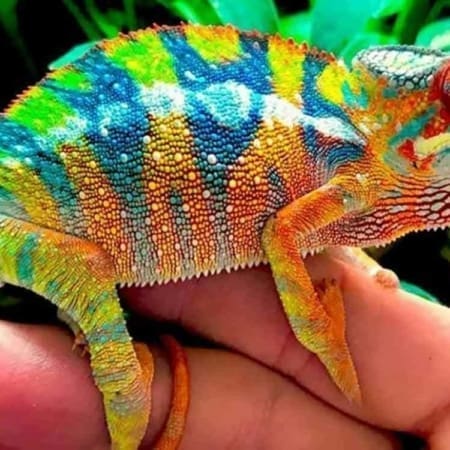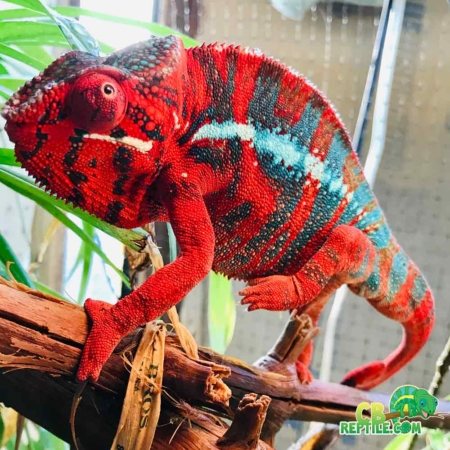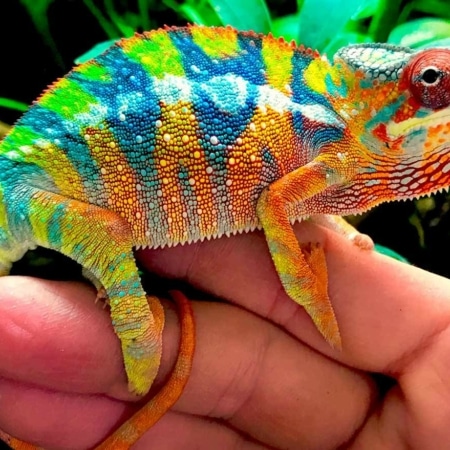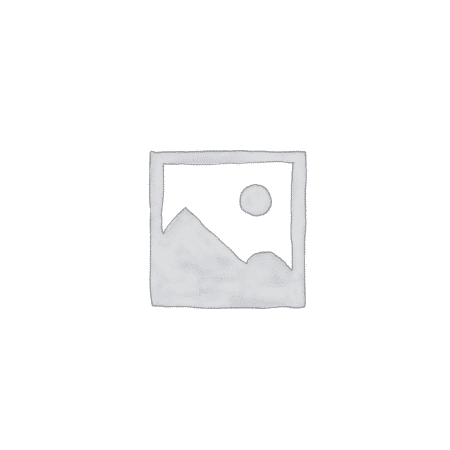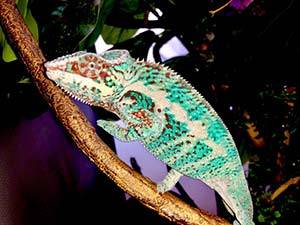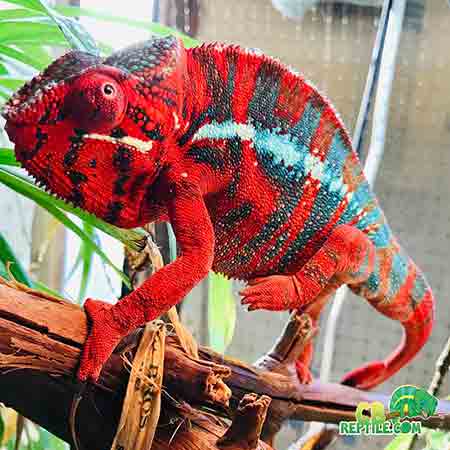Egg Laying Site Optimization & Nesting Setup for Panther Chameleons
One of the most critical aspects of breeding panther chameleons is providing a safe, secure, and properly designed egg-laying site. Female panther chameleons require a very specific environment to dig, deposit, and bury their clutch. Without this environment, they can become egg-bound—one of the most dangerous and potentially fatal conditions in captive husbandry. By understanding the natural behavior of nesting females and providing an optimized lay bin, keepers can ensure that gravid females lay safely, comfortably, and on schedule.
Beginning with a healthy, well-started female from the best panther chameleon breeder near me provides a major advantage. Captive-bred females possess stronger calcium reserves, more consistent reproductive cycles, and predictable nesting behavior compared to wild-caught females.

Understanding Natural Nesting Behavior
In Madagascar, female panther chameleons select shaded, moist, deep soil areas beneath dense vegetation to dig their nesting tunnels. They require solitude, stable substrate moisture, and complete privacy. Captive setups must replicate these natural conditions as closely as possible to reduce stress and ensure healthy laying events.
Typical Nesting Behavior Includes:
- Restless pacing throughout the enclosure
- Descending toward the bottom more frequently
- Testing soil by digging small “test holes”
- Reduced appetite
- Increased basking
- Dark gravid coloration if fertile
If these behaviors are observed, a nesting site must already be prepared, accessible, and familiar.

Building the Proper Laying Bin
A proper lay bin must satisfy several essential requirements: depth, moisture, privacy, and stability. Females will not lay if these conditions are not met.
✔ Minimum Dimensions
The laying bin must be deep enough to allow the female to dig a full tunnel without hitting the bottom or sides prematurely.
- Smallest acceptable size: 12″ wide × 12″ long × 12–14″ deep
- Recommended size: 16″ wide × 12″ long × 14–16″ deep
Bigger is always better for large females or high-egg-count locales.
✔ Substrate Type
The substrate must be moist enough to hold tunnels but not muddy. The two best substrate options are:
- Play sand (washed, clean, holds tunnels perfectly)
- Organic topsoil & sand mix (50/50)
✔ Substrate Moisture Level
A properly prepared substrate:
- Forms a tunnel without collapsing
- Feels moist like beach sand beneath the surface
- Is not dripping wet or dusty dry
A good test is the “fist test”—squeeze a handful; it should clump lightly but not drip.
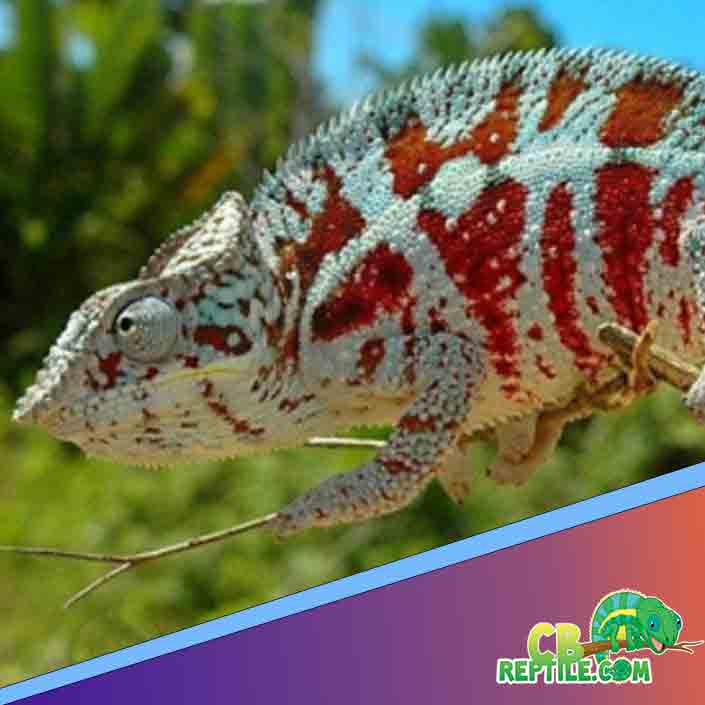
Placement of the Lay Bin
The lay bin must be easy for the female to access and placed in a quiet area of the enclosure.
Best Placement Options:
- Inside the enclosure along a back corner
- Half-buried under foliage for privacy
- Accessible via natural branch pathways
Never place the lay bin:
- In direct view of the room
- Near bright lights
- At the very front of the enclosure
- In a shallow or unstable location
If the female feels watched or unsafe, she will abandon digging attempts.
Creating Complete Privacy
Panther chameleons require absolute privacy during digging and laying. Stress triggers can cause females to abandon the nest—even after hours of work—resulting in egg retention.
To ensure privacy:
- Cover the sides of the enclosure with a towel or opaque material
- Keep foot traffic away during nesting
- Do not handle or disturb the female
- Reduce lighting intensity slightly in the nesting area
Many keepers mistakenly watch too closely—this is a major cause of egg binding.

Recognizing True Pre-Lay vs. False Pre-Lay Behavior
Not all digging behavior indicates imminent laying. Females sometimes perform “test digs” days or even weeks in advance.
False Pre-Lay (Test Digging):
- Female digs shallow, temporary holes
- Eats normally or slightly reduced
- Digs in multiple locations
- Stops digging unexpectedly
True Pre-Lay (Imminent Laying):
- Deep digging (several inches)
- Very restless pacing
- Appetite almost gone
- Dark gravid coloration
- Extended time staying in the lay bin
Knowing the difference helps keepers avoid unnecessary intervention.
The Egg-Laying Process
Once the female commits to the site, she will:
- Dig a tunnel, often sloping downward
- Enter the tunnel backward
- Deposit eggs (20–40 eggs on average)
- Pack the tunnel closed by tamping down substrate
- Cover the site completely
- Return to basking area looking significantly thinner
The entire process can take several hours—sometimes more than 12 hours for large clutches.

Post-Lay Care
After laying is complete, the female will be dehydrated and tired. Proper post-lay care is essential to avoid complications.
Post-Lay Care Checklist:
- Provide a long misting session for rehydration
- Offer hornworms or silkworms for moisture and protein
- Give extra calcium (without D3) for 1–2 weeks
- Allow complete privacy after laying
- Ensure basking area is warm but not excessive
Females typically recover quickly if properly cared for.
Preventing Egg Binding (Dystocia)
Egg binding is the most dangerous reproductive condition a female can experience. If a female cannot or will not lay her eggs, immediate intervention is required.
Causes of Egg Binding:
- Improper lay bin setup (inadequate depth or moisture)
- Poor calcium or vitamin balance
- Stress or lack of privacy
- Temperatures too low during gravidity
- Female too young or too small
Signs of Egg Binding:
- Weak grip strength
- Continuous digging but abandoning holes
- Visible straining
- Lack of appetite for more than 4–5 days
- Remaining at the bottom of the enclosure
Immediate veterinary care is essential if egg binding is suspected.
Preparing Eggs for Incubation
After the female lays, eggs should be carefully uncovered, removed, and placed in an incubation medium.
Incubation Substrate Options:
- Vermiculite
- Perlite
- HatchRite
Incubation Tips:
- Maintain stable humidity (70–90%)
- Keep eggs half-buried
- Avoid rotating eggs—orientation must remain the same
- Label clutch date and parental information
Panther chameleon eggs generally incubate between 180–270 days depending on temperature.
Choosing the Best Females for Breeding
When looking for a chameleons for sale suitable for breeding, always choose a captive-bred female with strong bone density, stable temperament, and predictable reproductive cycles. Reputable breeders ensure you always know buy chameleon online that will thrive through multiple healthy clutch cycles.
Final Thoughts on Egg Laying & Nesting
Providing a proper egg-laying site is essential for the safety and health of any female panther chameleon. With the right depth, substrate moisture, privacy, environmental stability, and post-lay care, females lay comfortably and reliably. By understanding nesting behavior and recognizing signs of distress early, keepers can prevent egg-binding and ensure successful reproduction season after season.
“`
—
# ✅ PAGE 4 COMPLETE
Ready for:
**Page 5 — Juvenile Growth Curve Management (0–12 Months)**

